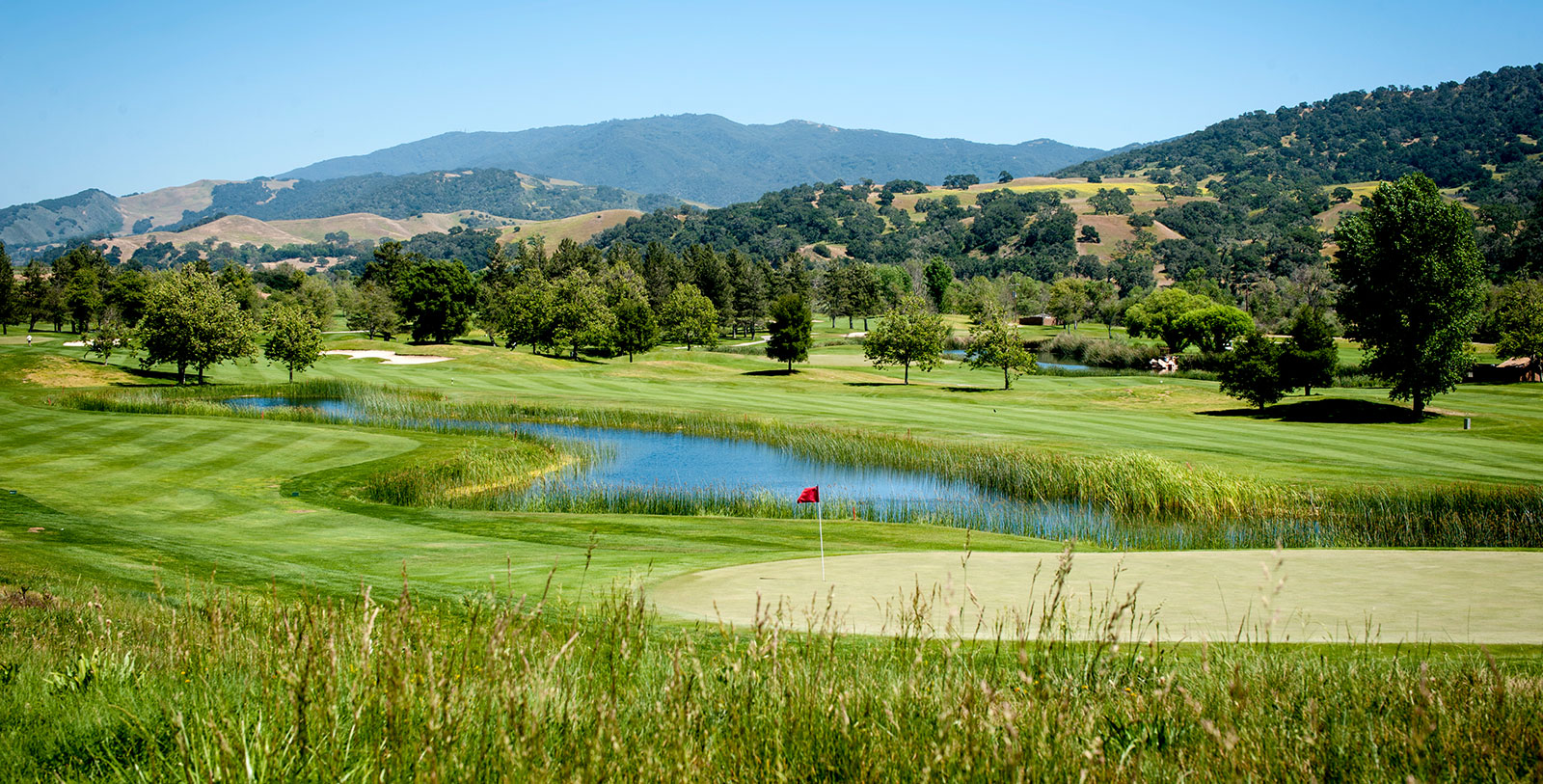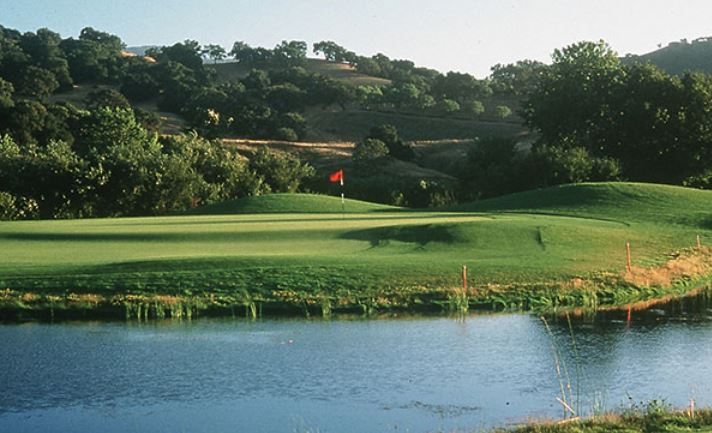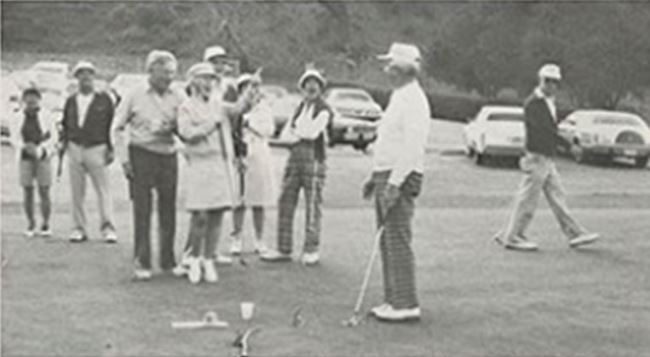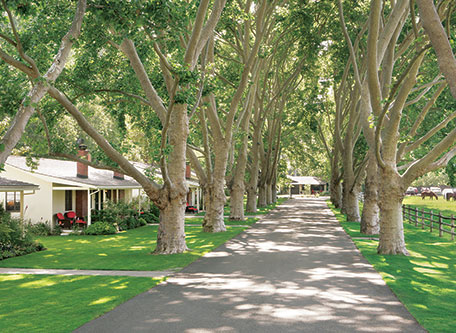Receive for Free - Discover & Explore eNewsletter monthly with advance notice of special offers, packages, and insider savings from 10% - 30% off Best Available Rates at selected hotels.
golf
Discover Alisal Ranch's two championship-caliber golf courses: The Ranch and River Courses.
Golf Getaway at Alisal Ranch
Golf at Alisal Ranch is definitely up to par! Step onto the freshly manicured greens of one of the two 18-hole championship courses for a round of golf amongst views of the Santa Ynez Mountains.
WATCH NOWGuests at Alisal Ranch in Solvang, California, can experience the pleasure of playing on the resort’s wonderful par-72, 18-hole championship golf course: The Ranch Course. The ancient oaks, manicured fairways, and spectacular panoramic views of the Santa Ynez area make the course a favorite among golf aficionados. The Ranch Course was designed by golf course architect William F. Bell Jr. and his renowned architectural firm, William P. Bell and Son. (The company’s name was an homage to Bell Jr.’s father, who had passed away two years before work on the Ranch Course began.) William F. Bell Jr. himself was a respected golf course designer at the time, having created numerous fairways at clubs all around the American Southwest. Bell Jr. proceeded to design the Ranch Course at the start of the 1950s, with construction beginning in earnest in 1954. He specifically extended the layout of the course through the majestic foothills of the Santa Ynez Mountains. Perhaps the best hole Bell Jr. created was the fifth, which offered stunning view of both Solvang and the Santa Ynez River. After months of construction, the Ranch Couse finally opened as a private facility for club members and resort guests in 1955. Measuring just over 6,5000 yards, the Ranch Course offered a good challenge for its players. As such, the course helped transform Alisal Ranch into one of California’s most celebrated golf retreats, its wonderful geography enchanting all who viewed it.
The resort’s second golf course—the River Course—opened to great acclaim several decades later in 1992. A public course, the River Course was specifically designed by the talented architects of the Hallsey Group. They succeeded in crafting another magnificent course that further exposed its players to the breathtaking sights of the Santa Ynez Mountains and Valley. The course itself featured four lakes and often followed the meandering path of the Santa Ynez River. Gentle mounds defined the manicured fairways and bentgrass greens accented by mature live oaks, native sycamores, and elderberry trees created a "must play" golf experience for all. At 6,830 yards, the Par 72-layout is still challenging today, but not punishing. The strategic placement of a variety of hazards rewards length and accuracy without severely penalizing recreational golfers. The moderate central California climate and meticulous golf course maintenance continue to provide excellent year-round playing conditions. The fairways remain wide, although the mounding along the sides requires accuracy to avoid sidehill lies. Elevated tees offer sweeping vistas of the fairways below, while the greens are large with moderate undulations that roll consistently. Since their debut, both courses have hosted Southern California PGA and Southern California Golf Association tournaments over the decades. Along with providing guests with tee times, the courses even host local championships and charity events.
-
About the Location +
Solvang, California, lies in the greater Santa Ynez Valley, a verdant sanctuary filled with many bucolic towns and rustic vineyards. The beautiful Santa Ynez River cuts through the heart of the valley, as the picturesque San Rafael and San Ynez Mountains border it to the north and south, respectively. Agriculture has long defined the entire area, specifically viticulture for which the region is well known. In fact, the Santa Ynez Valley is just one of a handful of distinct American Viticultural Areas, within which more than 50 different kinds of varietals thrive in the local climate. As such, the region is host to well over 100 wineries, with some of the best concentrated along the Foxen Canyon Wine Trail, as well as towns like Buellton, Lompoc, Los Olivos, and of course, Solvang. Solvang itself dates back to the early 20th century, although people had been living in the region for many years prior. Among the first were the Chumash people, who inhabited the space as hunter-gatherers. Yet, the Chumash were eventually joined by a group of Franciscan friars led by Father Estévan Tapís in the early 19th century. Father Tapís and the rest of his cohort had been tasked with the goal of founding a community that would link the preexisting missions of Santa Barbara and La Purisima Concepción. Receiving the title to thousands of acres in the area, they created their own mission—Mission Santa Inés—in 1804. Unfortunately, the priests had to completely rebuild their frontier settlement a decade later, when a ferocious earthquake struck the area. Nevertheless, the Franciscans repaired the mission, constructing a new church as well as two mills.
The Mission Santa Inés subsequently prospered for some time, until it was secularized in the wake of the Mexican War for Independence. The Mexican government subsequently granted most of the mission’s former land to several local ranchers who had arrived a few years prior, while leaving its church complex to operate as an independent entity. The site of the future town of Solvang was given to the prominent Carrillo family, who later christened it as the Rancho San Carlos de Jonata. But in the mid-1800s, a wave of new settlers flooded into the region, especially after California’s entrance into the Union following the Mexican-American War. Most of the settlers were Americans or European transplants who had started to move onto most of the older Mexican ranches, which had been abandoned from a variety of political and economic misfortune. (A drought had an especially profound impact upon the earlier Mexican landowners, forcing many to sell their land.) A large portion of the new migrants were Danish immigrants and their descendants, who had left several ethnic enclaves in the Midwest to found colonies along the Pacific coast. Many created the towns around “folk schools,” which were supposed to facilitate a spirit of freedom and cultural preservation. Interestingly, those Scandinavian immigrants continued to gradually relocate to the western United States for the better part of the next eight decades, with its climax occurring around the time of the Great Depression.
In 1911, one group of Danish and Danish-American migrants purchased some 9,000 acres of land within the old Rancho San Carlos de Jonata at an average price of 40 dollars per acre. They immediately set about founding a town near the historic Mission Santa Inés, calling their new community “Solvang.” Like many other Danish migrants at the time, the residents of Solvang quickly established a folk school called “Atterdag College” in order to help preserve their unique way of life. The locals also presided over the debut of a traditional Lutheran church, as well as a few specialized businesses. Yet, most of the buildings in downtown Solvang initially reflected similar architectural styles found in the neighboring towns in the Santa Ynez Valley. But the citizens of Solvang soon created a deep fascination with Danish architecture in the mid-20th century. They gradually transformed its downtown to feature new buildings that displayed the rich elements of Scandinavian architecture, including thatched roofs and half-timbering. (Many referred to the new architectural style as “Danish Provincial.”) A number of beautiful structures with Danish-inspired design aesthetics debuted all over town, including the great Tivoli Square. Four historically thematic windmills even opened in the heart of the community! In the present, Solvang has become one of California’s most famous vacation retreats. Its special Scandinavian culture attracts one million people from across the world every year. The village is also home to countless cultural attractions that include dozens of restaurants, boutique shops, and entertainment facilities. Few places can offer a fulfilling cultural heritage experience than Solvang, California.
-
About the Architect +
William F. Bell Jr.: One of America’s most prolific golf course designers, William F. Bell Jr., hailed from a family of renowned golf professionals. Indeed, the Bell family had been involved in the creation of championship-caliber fairways since the early 20th century. Bell’s father, William P. Bell, worked on his first course as the greenskeeper of the prestigious Pasadena Country Club right before the outbreak of World War I. He used the experience at Annadale to obtain actual work constructing golf courses alongside the renowned Willie Watson. Among the many outstanding courses that the senior Bell designed while working with Watson were the Hacienda Golf Club and the San Diego Country Club. William P. Bell even managed to help renovate the esteemed fairways at the Annadale Golf Club, specifically the redesign of its numerous hazards. But Bell finally decided to branch out on his own during the 1920s and began designing his own courses throughout the American Southwest. At first, Bell sought advice from another architect named George C. Thomas to perfect his designs. Perhaps one of the best designs he created with Thomas’ help was the Riviera Country Club in Los Angeles. In fact, Bell impressed Thomas so much that the former aided the latter on his own projects, like the course located at Ojai Valley Inn (which is also another member of Historic Hotels of America.) But by the time of the Great Depression and World War II, Bell had designed several courses on his own. Over time, he took his son, William F. Bell Jr., on as his apprentice and the two continued to work on golf courses in the western United States. In 1953, Bell Jr. assumed control over the family design firm, which he proceeded to run over the next three decades. Bell Jr. eventually designed over 200 courses throughout the country, including the fantastic Ranch Course at Alisal Ranch. His talents also facilitated Bell’s respected membership in the American Society of Golf Course Architects and even became its president for a time in the late 1950s.




































